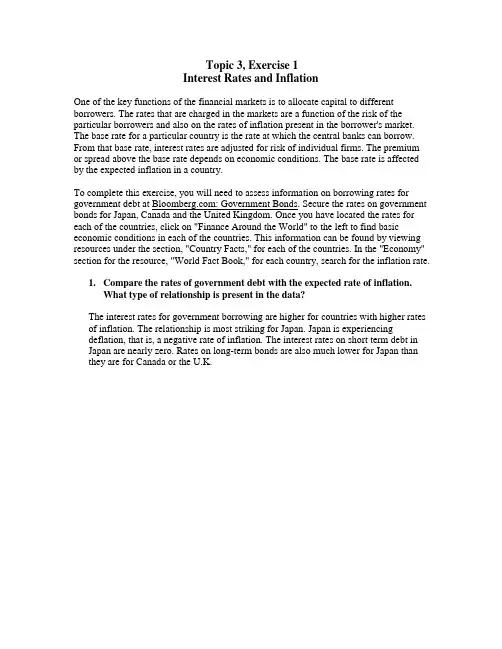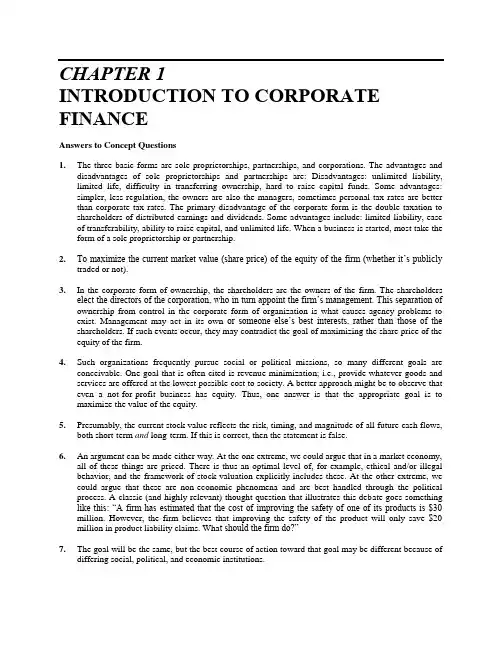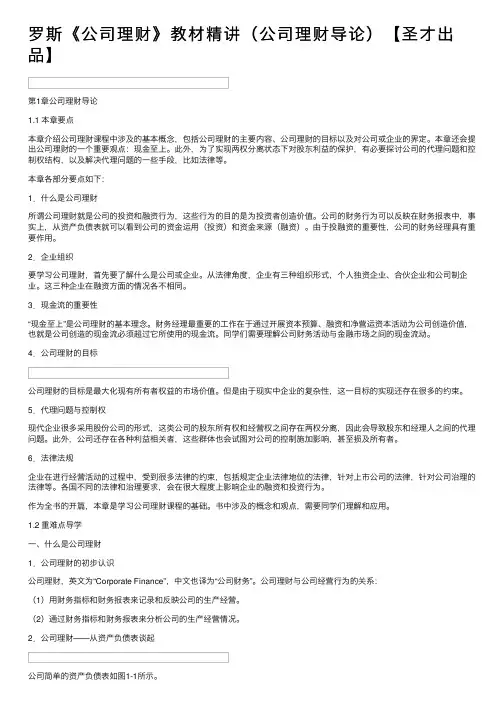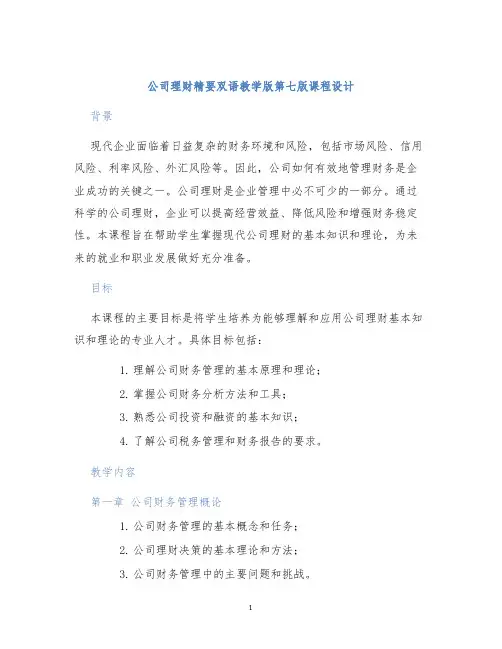罗斯《公司理财Corporate-Finance》(第七版)英文-Ch01课件
- 格式:ppt
- 大小:573.00 KB
- 文档页数:27


![[精选]罗斯《公司理财》(厦门大学沈艺峰老师)上](https://uimg.taocdn.com/8392fa5d814d2b160b4e767f5acfa1c7aa0082ec.webp)



Topic 3, Exercise 1Interest Rates and InflationOne of the key functions of the financial markets is to allocate capital to different borrowers. The rates that are charged in the markets are a function of the risk of the particular borrowers and also on the rates of inflation present in the borrower's market. The base rate for a particular country is the rate at which the central banks can borrow. From that base rate, interest rates are adjusted for risk of individual firms. The premium or spread above the base rate depends on economic conditions. The base rate is affected by the expected inflation in a country.To complete this exercise, you will need to assess information on borrowing rates for government debt at : Government Bonds. Secure the rates on government bonds for Japan, Canada and the United Kingdom. Once you have located the rates for each of the countries, click on "Finance Around the World" to the left to find basic economic conditions in each of the countries. This information can be found by viewing resources under the section, "Country Facts," for each of the countries. In the "Economy" section for the resource, "World Fact Book," for each country, search for the inflation rate.pare the rates of government debt with the expected rate of inflation.What type of relationship is present in the data?The interest rates for government borrowing are higher for countries with higher rates of inflation. The relationship is most striking for Japan. Japan is experiencingdeflation, that is, a negative rate of inflation. The interest rates on short term debt in Japan are nearly zero. Rates on long-term bonds are also much lower for Japan than they are for Canada or the U.K.。

CHAPTER 1INTRODUCTION TO CORPORATE FINANCEAnswers to Concept Questions1.The three basic forms are sole proprietorships, partnerships, and corporations. The advantages anddisadvantages of sole proprietorships and partnerships are: Disadvantages: unlimited liability, limited life, difficulty in transferring ownership, hard to raise capital funds. Some advantages: simpler, less regulation, the owners are also the managers, sometimes personal tax rates are better than corporate tax rates. The primary disadvantage of the corporate form is the double taxation to shareholders of distributed earnings and dividends. Some advantages include: limited liability, ease of transferability, ability to raise capital, and unlimited life. When a business is started, most take the form of a sole proprietorship or partnership.2.To maximize the current market value (share price) of the equity of the firm (whether it’s publiclytraded or not).3. In the corporate form of ownership, the shareholders are the owners of the firm. The shareholderselect the directors of the corporation, who in turn appoint the firm’s management. This separation of ownership from control in the corporate form of organization is what causes agency problems to exist. Management may act in its own or someone else’s best interests, rather than those of the shareholders. If such events occur, they may contradict the goal of maximizing the share price of the equity of the firm.4.Such organizations frequently pursue social or political missions, so many different goals areconceivable. One goal that is often cited is revenue minimization; i.e., provide whatever goods and services are offered at the lowest possible cost to society. A better approach might be to observe that even a not-for-profit business has equity. Thus, one answer is that the appropriate goal is to maximize the value of the equity.5.Presumably, the current stock value reflects the risk, timing, and magnitude of all future cash flows,both short-term and long-term. If this is correct, then the statement is false.6.An argument can be made either way. At the one extreme, we could argue that in a market economy,all of these things are priced. There is thus an optimal level of, for example, ethical and/or illegal behavior, and the framework of stock valuation explicitly includes these. At the other extreme, we could argue that these are non-economic phenomena and are best handled through the political process. A classic (and highly relevant) thought question that illustrates this debate goes something like this: “A firm has estimated that the cost of improving the safety of one of its products is $30 million. However, the firm believes that improving the safety of the product will only save $20 million in product liability claims. Wha t should the firm do?”7.The goal will be the same, but the best course of action toward that goal may be different because ofdiffering social, political, and economic institutions.8.The goal of management should be to maximize the share price for the current shareholders. Ifmanagement believes that it can improve the profitability of the firm so that the share price will exceed $35, then they should fight the offer from the outside company. If management believes that this bidder or other unidentified bidders will actually pay more than $35 per share to acquire the company, then they should still fight the offer. However, if the current management cannot increase the value of the firm beyond the bid price, and no other higher bids come in, then management is not acting in the interests of the shareholders by fighting the offer. Since current managers often lose their jobs when the corporation is acquired, poorly monitored managers have an incentive to fight corporate takeovers in situations such as this.9.We would expect agency problems to be less severe in other countries, primarily due to the relativelysmall percentage of individual ownership. Fewer individual owners should reduce the number of diverse opinions concerning corporate goals. The high percentage of institutional ownership might lead to a higher degree of agreement between owners and managers on decisions concerning risky projects. In addition, institutions may be better able to implement effective monitoring mechanisms on managers th an can individual owners, based on the institutions’ deeper resources and experiences with their own management. The increase in institutional ownership of stock in the United States and the growing activism of these large shareholder groups may lead to a reduction in agency problems for U.S. corporations and a more efficient market for corporate control.10. How much is too much? Who is worth more, Jack Welch or Tiger Woods? The simplest answer isthat there is a market for executives just as there is for all types of labor. Executive compensation is the price that clears the market. The same is true for athletes and performers. Having said that, one aspect of executive compensation deserves comment. A primary reason that executive compensation has grown so dramatically is that companies have increasingly moved to stock-based compensation.Such movement is obviously consistent with the attempt to better align stockholder and management interests. In recent years, stock prices have soared, so management has cleaned up. It is sometimes argued that much of this reward is simply due to rising stock prices in general, not managerial performance. Perhaps in the future, executive compensation will be designed to reward only differential performance, i.e., stock price increases in excess of general market increases.。

罗斯《公司理财》教材精讲(公司理财导论)【圣才出品】第1章公司理财导论1.1 本章要点本章介绍公司理财课程中涉及的基本概念,包括公司理财的主要内容、公司理财的⽬标以及对公司或企业的界定。
本章还会提出公司理财的⼀个重要观点:现⾦⾄上。
此外,为了实现两权分离状态下对股东利益的保护,有必要探讨公司的代理问题和控制权结构,以及解决代理问题的⼀些⼿段,⽐如法律等。
本章各部分要点如下:1.什么是公司理财所谓公司理财就是公司的投资和融资⾏为,这些⾏为的⽬的是为投资者创造价值。
公司的财务⾏为可以反映在财务报表中,事实上,从资产负债表就可以看到公司的资⾦运⽤(投资)和资⾦来源(融资)。
由于投融资的重要性,公司的财务经理具有重要作⽤。
2.企业组织要学习公司理财,⾸先要了解什么是公司或企业。
从法律⾓度,企业有三种组织形式,个⼈独资企业、合伙企业和公司制企业。
这三种企业在融资⽅⾯的情况各不相同。
3.现⾦流的重要性“现⾦⾄上”是公司理财的基本理念。
财务经理最重要的⼯作在于通过开展资本预算、融资和净营运资本活动为公司创造价值,也就是公司创造的现⾦流必须超过它所使⽤的现⾦流。
同学们需要理解公司财务活动与⾦融市场之间的现⾦流动。
4.公司理财的⽬标公司理财的⽬标是最⼤化现有所有者权益的市场价值。
但是由于现实中企业的复杂性,这⼀⽬标的实现还存在很多的约束。
5.代理问题与控制权现代企业很多采⽤股份公司的形式,这类公司的股东所有权和经营权之间存在两权分离,因此会导致股东和经理⼈之间的代理问题。
此外,公司还存在各种利益相关者,这些群体也会试图对公司的控制施加影响,甚⾄损及所有者。
6.法律法规企业在进⾏经营活动的过程中,受到很多法律的约束,包括规定企业法律地位的法律,针对上市公司的法律,针对公司治理的法律等。
各国不同的法律和治理要求,会在很⼤程度上影响企业的融资和投资⾏为。
作为全书的开篇,本章是学习公司理财课程的基础。
书中涉及的概念和观点,需要同学们理解和应⽤。


公司理财精要双语教学版第七版课程设计背景现代企业面临着日益复杂的财务环境和风险,包括市场风险、信用风险、利率风险、外汇风险等。
因此,公司如何有效地管理财务是企业成功的关键之一。
公司理财是企业管理中必不可少的一部分。
通过科学的公司理财,企业可以提高经营效益、降低风险和增强财务稳定性。
本课程旨在帮助学生掌握现代公司理财的基本知识和理论,为未来的就业和职业发展做好充分准备。
目标本课程的主要目标是将学生培养为能够理解和应用公司理财基本知识和理论的专业人才。
具体目标包括:1.理解公司财务管理的基本原理和理论;2.掌握公司财务分析方法和工具;3.熟悉公司投资和融资的基本知识;4.了解公司税务管理和财务报告的要求。
教学内容第一章公司财务管理概论1.公司财务管理的基本概念和任务;2.公司理财决策的基本理论和方法;3.公司财务管理中的主要问题和挑战。
1.公司财务报表的基本原理和要素;2.财务比率分析和财务指标的应用;3.公司财务预测分析和风险评估。
第三章公司资本结构和资本成本1.公司资本结构的基本概念和理论;2.资本结构的权益和债务比例的决定;3.资本成本的计算方法和应用。
第四章公司投资决策1.投资决策的基本概念和方法;2.投资项目的评价和选择;3.投资组合管理和风险控制。
第五章公司融资决策1.融资决策的基本概念和方法;2.资本市场和公司融资工具;3.融资成本的评估和控制。
第六章公司价值管理1.公司价值的概念和理论;2.公司价值评估和管理;3.股价波动和市场效应的影响。
1.公司税务制度和纳税申报;2.利润分配与税务效应;3.税务筹划和风险控制。
教学方法本课程采用双语教学方法,以授课、案例研究、小组讨论和课程作业等模式相结合,帮助学生从理论、实践和应用角度全面学习公司理财相关知识。
考核标准学生将通过课程作业、小组讨论、期末论文和期末考试的形式进行评估,各项评估的比例如下:1.课程作业(20%):包括课上、课下和实践考察;2.小组讨论(20%):考察学生合作、沟通、解决问题和创新能力;3.期末论文(30%):考察学生的撰写能力、理论研究和实践应用;4.期末考试(30%):考察学生对课程知识的掌握程度和理解能力。

Chapter 01 - Introduction to Corporate FinanceChapter 01 Introduction to Corporate Finance Answer KeyMultiple Choice Questions1. The person generally directly responsible for overseeing the tax management, cost accounting, financial accounting, and information system functions is the:A. treasurer.B. director.C. controller.D. chairman of the board.E. chief executive officer.Difficulty level: EasyTopic: CONTROLLERType: DEFINITIONS2. The person generally directly responsible for overseeing the cash and credit functions,financial planning, and capital expenditures is the:A. treasurer.B. director.C. controller.D. chairman of the board.E. chief operations officer.1-1Chapter 01 - Introduction to Corporate Finance3. The process of planning and managing a firm's long-term investments is called:A. working capital management.B. financial depreciation.C. agency cost analysis.D. capital budgeting.E. capital structure.Difficulty level: EasyTopic: CAPITAL BUDGETINGType: DEFINITIONS4. The mixture of debt and equity used by a firm to finance its operations is called:A. working capital management.B. financial depreciation.C. cost analysis.D. capital budgeting.E. capital structure.5. The management of a firm's short-term assets and liabilities is called:A. working capital management.B. debt management.C. equity management.D. capital budgeting.E. capital structure.1-2Chapter 01 - Introduction to Corporate Finance6. A business owned by a single individual is called a:A. corporation.B. sole proprietorship.C. general partnership.D. limited partnership.E. limited liability company.7. A business formed by two or more individuals who each have unlimited liability for businessdebts is called a:A. corporation.B. sole proprietorship.C. general partnership.D. limited partnership.E. limited liability company.8. The division of profits and losses among the members of a partnership is formalized in the:A. indemnity clause.B. indenture contract.C. statement of purpose.D. partnership agreement.E. group charter.9. A business created as a distinct legal entity composed of one or more individuals or entities iscalled a:A. corporation.B. sole proprietorship.C. general partnership.D. limited partnership.E. unlimited liability company.Difficulty level: EasyTopic: CORPORATIONType: DEFINITIONS1-3Chapter 01 - Introduction to Corporate Finance10. The corporate document that sets forth the business purpose of a firm is the:A. indenture contract.B. state tax agreement.C. corporate bylaws.D. debt charter.E. articles of incorporation.11. The rules by which corporations govern themselves are called:A. indenture provisions.B. indemnity provisions.C. charter agreements.D. bylaws.E. articles of incorporation.12. A business entity operated and taxed like a partnership, but with limited liability for theowners, is called a:A. limited liability company.B. general partnership.C. limited proprietorship.D. sole proprietorship.E. corporation.13. The primary goal of financial management is to:A. maximize current dividends per share of the existing stock.B. maximize the current value per share of the existing stock.C. avoid financial distress.D. minimize operational costs and maximize firm efficiency.E. maintain steady growth in both sales and net earnings.14. A conflict of interest between the stockholders and management of a firm is called:A. stockholders' liability.B. corporate breakdown.C. the agency problem.D. corporate activism.E. legal liability.1-4Chapter 01 - Introduction to Corporate Finance15. Agency costs refer to:A. the total dividends paid to stockholders over the lifetime of a firm.B. the costs that result from default and bankruptcy of a firm.C. corporate income subject to double taxation.D. the costs of any conflicts of interest between stockholders and management.E. the total interest paid to creditors over the lifetime of the firm.16. A stakeholder is:A. any person or entity that owns shares of stock of a corporation.B. any person or entity that has voting rights based on stock ownership of a corporation.C. a person who initially started a firm and currently has management control over the cashflows of the firm due to his/her current ownership of company stock.D. a creditor to whom the firm currently owes money and who consequently has a claim on thecash flows of the firm.E. any person or entity other than a stockholder or creditor who potentially has a claim on thecash flows of the firm.17. The Sarbanes Oxley Act of 2002 is intended to:A. protect financial managers from investors.B. not have any effect on foreign companies.C. reduce corporate revenues.D. protect investors from corporate abuses.E. decrease audit costs for U.S. firms.18. The treasurer and the controller of a corporation generally report to the:A. board of directors.B. chairman of the board.C. chief executive officer.D. president.E. chief financial officer.19. Which one of the following statements is correct concerning the organizational structure ofa corporation?A. The vice president of finance reports to the chairman of the board.B. The chief executive officer reports to the board of directors.C. The controller reports to the president.D. The treasurer reports to the chief executive officer.E. The chief operations officer reports to the vice president of production.Difficulty level: MediumTopic: ORGANIZATIONAL STRUCTUREType: CONCEPTS1-5Chapter 01 - Introduction to Corporate Finance20. Which one of the following is a capital budgeting decision?A. determining how much debt should be borrowed from a particular lenderB. deciding whether or not to open a new storeC. deciding when to repay a long-term debtD. determining how much inventory to keep on handE. determining how much money should be kept in the checking account21. The Sarbanes Oxley Act was enacted in:A. 1952.B. 1967.C. 1998.D. 2002.E. 2006.22. Since the implementation of Sarbanes-Oxley, the cost of going public in the United Stateshas:A. increased.B. decreased.C. remained about the same.D. been erratic, but over time has decreased.E. It is impossible to tell since Sarbanes-Oxley compliance does not involve direct cost to thefirm.23. Working capital management includes decisions concerning which of the following?I. accounts payableII. long-term debtIII. accounts receivableIV. inventoryA. I and II onlyB. I and III onlyC. II and IV onlyD. I, II, and III onlyE. I, III, and IV onlyDifficulty level: MediumTopic: WORKING CAPITAL MANAGEMENTType: CONCEPTS1-6Chapter 01 - Introduction to Corporate Finance24. Working capital management:A. ensures that sufficient equipment is available to produce the amount of product desired on adaily basis.B. ensures that long-term debt is acquired at the lowest possible cost.C. ensures that dividends are paid to all stockholders on an annual basis.D. balances the amount of company debt to the amount of available equity.E. is concerned with the upper portion of the balance sheet.Difficulty level: EasyTopic: WORKING CAPITAL MANAGEMENTType: CONCEPTS25. Which one of the following statements concerning a sole proprietorship is correct?A. A sole proprietorship is the least common form of business ownership.B. The profits of a sole proprietorship are taxed twice.C. The owners of a sole proprietorship share profits as established by the partnership agreement.D. The owner of a sole proprietorship may be forced to sell his/her personal assets to paycompany debts.E. A sole proprietorship is often structured as a limited liability company.Difficulty level: EasyTopic: SOLE PROPRIETORSHIPType: CONCEPTS26. Which one of the following statements concerning a sole proprietorship is correct?A. The life of the firm is limited to the life span of the owner.B. The owner can generally raise large sums of capital quite easily.C. The ownership of the firm is easy to transfer to another individual.D. The company must pay separate taxes from those paid by the owner.E. The legal costs to form a sole proprietorship are quite substantial.Difficulty level: EasyTopic: SOLE PROPRIETORSHIPType: CONCEPTS1-7Chapter 01 - Introduction to Corporate Finance27. Which one of the following best describes the primary advantage of being a limited partnerrather than a general partner?A. entitlement to a larger portion of the partnership's incomeB. ability to manage the day-to-day affairs of the businessC. no potential financial lossD. greater management responsibilityE. liability for firm debts limited to the capital investedDifficulty level: EasyTopic: PARTNERSHIPType: CONCEPTS28. A general partner:A. has less legal liability than a limited partner.B. has more management responsibility than a limited partner.C. faces double taxation whereas a limited partner does not.D. cannot lose more than the amount of his/her equity investment.E. is the term applied only to corporations which invest in partnerships.Difficulty level: EasyTopic: PARTNERSHIPType: CONCEPTS29. A partnership:A. is taxed the same as a corporation.B. agreement defines whether the business income will be taxed like a partnership or acorporation.C. terminates at the death of any general partner.D. has less of an ability to raise capital than a proprietorship.E. allows for easy transfer of interest from one general partner to another.Difficulty level: EasyTopic: PARTNERSHIPType: CONCEPTS1-8Chapter 01 - Introduction to Corporate Finance30. Which of the following are disadvantages of a partnership?I. limited life of the firmII. personal liability for firm debtIII. greater ability to raise capital than a sole proprietorshipIV. lack of ability to transfer partnership interestA. I and II onlyB. III and IV onlyC. II and III onlyD. I, II, and IV onlyE. I, III, and IV onlyDifficulty level: MediumTopic: PARTNERSHIPType: CONCEPTS31. Which of the following are advantages of the corporate form of business ownership?I. limited liability for firm debtII. double taxationIII. ability to raise capitalIV. unlimited firm lifeA. I and II onlyB. III and IV onlyC. I, II, and III onlyD. II, III, and IV onlyE. I, III, and IV onlyDifficulty level: MediumTopic: CORPORATIONType: CONCEPTS32. Which one of the following statements is correct concerning corporations?A. The largest firms are usually corporations.B. The majority of firms are corporations.C. The stockholders are usually the managers of a corporation.D. The ability of a corporation to raise capital is quite limited.E. The income of a corporation is taxed as personal income of the stockholders.Difficulty level: EasyTopic: CORPORATIONType: CONCEPTS1-9Chapter 01 - Introduction to Corporate Finance33. Which one of the following statements is correct?A. Both partnerships and corporations incur double taxation.B. Both sole proprietorships and partnerships are taxed in a similar fashion.C. Partnerships are the most complicated type of business to form.D. Both partnerships and corporations have limited liability for general partners and shareholders.E. All types of business formations have limited lives.Difficulty level: MediumTopic: BUSINESS TYPESType: CONCEPTS34. The articles of incorporation:A. can be used to remove company management.B. are amended annually by the company stockholders.C. set forth the number of shares of stock that can be issued.D. set forth the rules by which the corporation regulates its existence.E. can set forth the conditions under which the firm can avoid double taxation.35. The bylaws:A. establish the name of the corporation.B. are rules which apply only to limited liability companies.C. set forth the purpose of the firm.D. mandate the procedure for electing corporate directors.E. set forth the procedure by which the stockholders elect the senior managers of the firm.36. The owners of a limited liability company prefer:A. being taxed like a corporation.B. having liability exposure similar to that of a sole proprietor.C. being taxed personally on all business income.D. having liability exposure similar to that of a general partner.E. being taxed like a corporation with liability like a partnership.Difficulty level: MediumTopic: LIMITED LIABILITY COMPANYType: CONCEPTS1-10Chapter 01 - Introduction to Corporate Finance37. Which one of the following business types is best suited to raising large amounts ofcapital?A. sole proprietorshipB. limited liability companyC. corporationD. general partnershipE. limited partnershipDifficulty level: EasyTopic: CORPORATIONType: CONCEPTS38. Which type of business organization has all the respective rights and privileges ofa legalperson?A. sole proprietorshipB. general partnershipC. limited partnershipD. corporationE. limited liability companyDifficulty level: EasyTopic: CORPORATIONType: CONCEPTS39. Financial managers should strive to maximize the current value per share of the existingstock because:A. doing so guarantees the company will grow in size at the maximum possible rate.B. doing so increases the salaries of all the employees.C. the current stockholders are the owners of the corporation.D. doing so means the firm is growing in size faster than its competitors.E. the managers often receive shares of stock as part of their compensation.Difficulty level: EasyTopic: GOAL OF FINANC IAL MANAGEMENTType: CONCEPTS1-11Chapter 01 - Introduction to Corporate Finance40. The decisions made by financial managers should all be ones which increase the:A. size of the firm.B. growth rate of the firm.C. marketability of the managers.D. market value of the existing owners' equity.E. financial distress of the firm.Difficulty level: EasyTopic: GOAL OF FINANCIAL MANAGEMENTType: CONCEPTS41. Which one of the following actions by a financial manager creates an agency problem?A. refusing to borrow money when doing so will create losses for the firmB. refusing to lower selling prices if doing so will reduce the net profitsC. agreeing to expand the company at the expense of stockholders' valueD. agreeing to pay bonuses based on the book value of the company stockE. increasing current costs in order to increase the market value of the stockholders' equity42. Which of the following help convince managers to work in the best interest of the stockholders?I. compensation based on the value of the stockII. stock option plansIII. threat of a proxy fightIV. threat of conversion to a partnershipA. I and II onlyB. II and III onlyC. I, II and III onlyD. I and III onlyE. I, II, III, and IVDifficulty level: MediumTopic: AGENCY PROBLEMType: CONCEPTS1-12Chapter 01 - Introduction to Corporate Finance43. Which form of business structure faces the greatest agency problems?A. sole proprietorshipB. general partnershipC. limited partnershipD. corporationE. limited liability company44. A proxy fight occurs when:A. the board solicits renewal of current members.B. a group solicits proxies to replace the board of directors.C. a competitor offers to sell their ownership in the firm.D. the firm files for bankruptcy.E. the firm is declared insolvent.45. Which one of the following parties is considered a stakeholder of a firm?A. employeeB. short-term creditorC. long-term creditorD. preferred stockholderE. common stockholderDifficulty level: EasyTopic: STAKEHOLDERSType: CONCEPTS46. Which of the following are key requirements of the Sarbanes-Oxley Act?I. Officers of the corporation must review and sign annual reports.II. Officers of the corporation must now own more than 5% of the firm's stock. III. Annual reports must list deficiencies in internal controlsIV. Annual reports must be filed with the SEC within 30 days of year end.A. I onlyB. II onlyC. I and III onlyD. II and III onlyE. II and IV onlyDifficulty level: MediumTopic: SARBANES-OXLEYType: CONCEPTS1-13Chapter 01 - Introduction to Corporate Finance47. Insider trading is:A. legal.B. illegal.C. impossible to have in our efficient market.D. discouraged, but legal.E. list only the securities of the largest firms.48. Sole proprietorships are predominantly started because:A. they are easily and cheaply setup.B. the proprietorship life is limited to the business owner's life.C. all business taxes are paid as individual tax.D. All of the above.E. None of the above.Difficulty level: EasyTopic: SOLE PROPRIETORSHIPSType: CONCEPTS49. Managers are encouraged to act in shareholders' interests by:A. shareholder election of a board of directors who select management.B. the threat of a takeover by another firm.C. compensation contracts that tie compensation to corporate success.D. Both A and B.E. All of the above.Difficulty level: MediumTopic: GOVERNANCEType: CONCEPTS50. The Securities Exchange Act of 1934 focuses on:A. all stock transactions.B. sales of existing securities.C. issuance of new securities.D. insider trading.E. Federal Deposit Insurance Corporation (FDIC) insurance.Difficulty level: MediumTopic: REGULATIONType: CONCEPTS1-14Chapter 01 - Introduction to Corporate Finance51. The basic regulatory framework in the United States was provided by:A. the Securities Act of 1933.B. the Securities Exchange Act of 1934.C. the monetary system.D. A and B.E. All of the above.Difficulty level: MediumTopic: REGULATIONType: CONCEPTS52. The Securities Act of 1933 focuses on:A. all stock transactions.B. sales of existing securities.C. issuance of new securities.D. insider trading.E. Federal Deposit Insurance Corporation (FDIC) insurance.Difficulty level: EasyTopic: REGULATIONType: CONCEPTS53. In a limited partnership:A. each limited partner's liability is limited to his net worth.B. each limited partner's liability is limited to the amount he put into the partnership.C. each limited partner's liability is limited to his annual salary.D. there is no limitation on liability; only a limitation on what the partner can earn.E. None of the above.Difficulty level: EasyTopic: LIMITED PARTNERSHIPType: CONCEPTS1-15Chapter 01 - Introduction to Corporate Finance54. Accounting profits and cash flows are:A. generally the same since they reflect current laws and accounting standards.B. generally the same since accounting profits reflect when the cash flows are received.C. generally not the same since GAAP allows for revenue recognition separate from the receiptof cash flows.D. generally not the same because cash inflows occur before revenue recognition.E. Both c and d.1-16。